340
Views & Citations10
Likes & Shares
INTRODUCTION
Sport, Games and exercise are useful for our health. Sound mind and sound body is a result of games and playing. In an interdisciplinary science called sport psychology is a combination of kinesiology and psychology. In this science it is studied that how various sport activities are helpful for improve one‘s performance in various angles. In addition to instruction and training of psychological skills for performance improvement, applied sport psychology may include work with athletes, coaches, and parents regarding injury, rehabilitation, communication, team building, and career transitions. The birth of sports psychology in Europe happened largely in Germany. The first sports psychology laboratory was founded by Dr. Carl Diem in Berlin, in the early 1920s, (Cole, B., 2012). Games like Football, Wrestling and Basketball, Golf are beneficial for children learn to work together and use appropriate social skills. Co-operative hoops are the useful for understand the concept of inclusion and that everyone belongs no matter the situation. Some games like Kabaddi, Kho-kho are helpful to develop cooperation skills. Well-designed sequences of challenging physical activity can lay important foundations for physical health and well-being. Physical activity also contributes to psycho- social development. Or physical activities can simply be used for fun. The new and recent trend is related to sedentary games. Like VDO games, the concerned about the effects of video games on your health? Or perhaps you‘re just curious about this stuff or need to research it for a study.We know that exercise has positive effects on the brain. Researchers at Duke University demonstrated several years ago that exercise has antidepressant properties. Other research has shown that exercise can improve the brain functioning of the elderly and may even protect against dementia.
One theory for some of the benefits of exercise includes the fact that exercise triggers the production of endorphins. These natural opiates are chemically similar to morphine. They may be produced as natural pain relievers in response to the shock that the body receives during exercise. However, researchers are beginning to question whether endorphins improve mood. Studies are showing that the body's metabolism of endorphins is complex, and there are likely additional mechanisms involved in the mental health effects of exercise.
Some studies have found that exercise boosts activity in the brain's frontal lobes and the hippocampus. We don't really know how or why this occurs. Animal studies have found that exercise increases levels of serotonin, dopamine and norepinephrine. These neurotransmitters have been associated with elevated mood, and it is thought that antidepressant medications also work by boosting these chemicals.
Exercise has also been found to increase levels of "brain-derived neurotrophic factor" (BDNF). This substance is thought to improve mood, and it may play a role in the beneficial effects of exercise. BDNF's primary role seems to be to help brain cells survive longer, so this may also explain some of the beneficial effects of exercise on dementia.
Applied sport and exercise psychology consists of instructing athletes, coaches, teams, exercisers, parents, fitness professionals, groups, and other performers on the psychological aspects of their sport or activity. The goal of applied practice is to optimize performance and enjoyment through the use of psychological skills.
It is pertinent to mention that the practice of applied sport psychology is not legally restricted to individuals who possess one type of certification or licensure. The subject of "what exactly constitutes applied sport psychology and who can practice it?" has been debated amongst sport psychology professionals, and as of 2011, still lacks formal legal resolution in the United States. For instance, some question the ability of professionals who possess only sport science or kinesiology training to practice "psychology" with clients, while others counter that clinical and counseling psychologists without training in sport science do not have the professional competency to work with athletes. The bottom line is that most of us feel good after exercise. Physical exercise is good for our mental health and for our brains. Someday we will understand it all better - but we can start exercising today.
RESEARCH METHODOLOGY
In this chapter, the overall design of the study, the research questions, the population and sample selection of the study, the data collection instruments, the data collection procedure, and the data analysis methods are presented.
Here, researcher mention complete methodology of the research work such as objectives, hypotheses, research design, sample of the study, details about tools and data collection, the scoring and the data analysis. According to the need of present research researcher has implied here survey research technique. Survey research is a new technique for social science research. Survey, as such, is quite an old technique and was largely developed in the eighteenth century. However, in the second part of the nineteenth century a systematic literature was made available by Booth who is regarded as the father of scientific social surveys (Moser & Kalton, 1971). But survey research as a special branch of social science research, is considered as a new technique developed in the twentieth century.
Survey research, mostly used by psychologists, sociologists and anthropologists, should be distinguished from sample survey, which is its close ally. The survey researcher is primarily interested in assessing the characteristics of the whole p0pulation, thus, survey research may be defined as a technique whereby the researcher studies the whole population with respect to certain sociological and psychological variables. For example, if a researcher wants to study how many people of both sexes in India adopt contraceptive devices as a measure of birth control, this will constitute an example of survey research. But a survey researcher rarely takes pains to make an approach to each member of the population or universe probably because it requires a lot of time, money and patience. Thus he takes a convenient random sample, which is considered to be representative of the whole universe and subsequently, an inference regarding the entire population is drawn, when a researcher takes a sample from the population for studying the relative incidence, distribution and relationship of psychological and sociological variables, the survey is termed as a sample survey.
Survey research depends upon three important factors:
As survey research deals with the characteristics, attitudes and behaviors of individuals or a group of individuals called a sample, direct contact with those persons must be established by the survey researcher.
The success of survey research depends upon the willingness and the co- cooperativeness of the sample selected for the study. The people selected for the survey research must be willing to give the desired information. In case, they are not willing and do not co-operate with the survey researcher, he should drop the plan in favor of some other technique.
Survey research requires that the researcher be trained personnel. He must have manipulative skill and research insight. He must possess social intelligence so that he may deal with people effectively and be able to extract the desired information from them.
POPULATION
The purpose of this study is to study/examine the difference between player students and non-player students and their psychological and physical health as well as their gender differences and their overall improvements through the games.
The population for this study consisted of all the secondary school students from the Chandwad tehsil (School List Attached in Appendix).
SAMPLE
In the present study researcher try to achieve four goals of research in management: Description, prediction, understanding, and creating change. Researcher used survey research method to develop detailed descriptions of behavior, often in natural settings. Survey research method allow researcher to describe people's attitudes and opinions. Researcher will able to make predictions about behavior and mental processes when he or she discovers measures and observations of secondary students. Description and prediction are essential to the scientific study of behavior; researcher also seeks for understanding the "why" of behavior. We achieve scientific understanding when we identify the causes of a phenomenon.
Present study is a type of survey research and based on random sampling. With respect to this research, the researcher will have used suitable methodology and planned an appropriate research design. Following are the points involved in the research methodology:
- Selection of the appropriate sample design for the
- Application of the appropriate research design in the
- Selection of the appropriate tools for the
- Selection of the appropriate method for data
- Administration of tools and data
- Interpretation and analysis of the data by using appropriate statistical
- Interpretation of the results and drawing
Selection of the sample
This is a survey type research. For the present study it has been decided to choose 300 Boys and 300 Girls from Chandwad taluka. In it, 150 Boys are involved in physical education training which is selected as players and 150 boys are non-players. As well as 150 girls are involved in physical education training and 150 girls are free from physical education training and activities. Maximum care was taken to select appropriate sampling. Total 600 samples selected for the present research. All the secondary students were educated and studying in various schools. The age group of respondents was between 10 to 15 years. The sample selection method was used as random sampling technique. The demographical area was limited to Chandwad tehsil. No socio-economic background was considered.
Objectives of the study
- To study the physical education aspect of the secondary school
- To examine the various aspects of the mental health of secondary school
- To identify the benefits of physical education and
- To examine the assertiveness aspect of secondary school
- To analyze the effect of exercise on the mental health and assertiveness of secondary school
Hypotheses
- Students who involved in physical education activities are show better mental health characteristics than those who are not involved in physical
- Boys student of secondary education have better mental health than girl
- Students who involved in physical education activities are more assertive than those who are not involved in physical
- Boys student of secondary education are more assertive than girl
- There is a positive relationship between physical education and mental
- There is a positive relationship between physical education and assertiveness.
Variables
Categorical Variables
- Type of students: i) Players and ii) Non-player students
- Gender: i) Boys students and ii) Girl Students
Continuous Variables
- Mental Health
- Assertiveness
Operational definitions
Following are the operational definitions which are involved in the present study according to need and use of the study.
Secondary School students: Those students who are studying in class V to X.
Players: Those who are participated in various games and regularly practices of physical education exercises.
Physical education: Physical education activities are running, jumping, play various individual and group games.
Mental health: Jahoda, (1958) argues that positive mental health can be viewed as an enduring personality characteristic or as a less permanent function of personality and the social situation. In the present study it is decided that the total raw score is called as mental health of school students.
Assertiveness: Assertiveness is defined as standing up for personal rights, expressing thoughts, feelings and beliefs in direct, honest and appropriate ways which respect the rights of other people. Cumulative score of assertiveness inventory is called as assertiveness of school students.
Research Design
For the present research, following type of research design i.e. 2X2 is carried out (Table 1).
Tools for data collection following Table 2.

Mental health inventory
To assess the level of positive mental health in secondary school student, Mental Health Inventory developed by Jagdish & Srivastava, (1998) has been used. In the present inventory there are 56 items including 32 ‗false keyed ‘and 24 ‗true-keyed’. The present inventory assesses six dimensions of positive mental health. They are:
- Positive self-evaluation
- Perception of reality
- Integration of personality
- Autonomy
- Group oriented attitude and
- Environmental mastery
Reliability of the inventory
The reliability of the inventory was determined by split-half method using odd-even procedure. The table gives the reliability coefficients of different dimensions of mental health and overall (Table 3).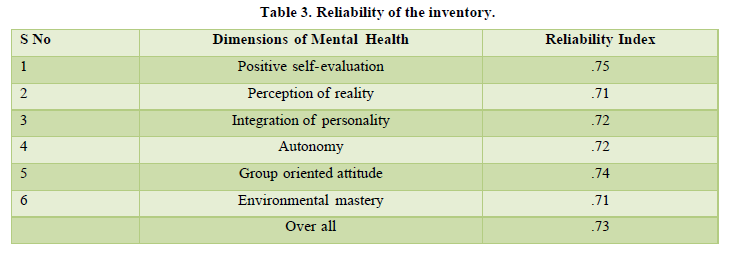
Validity of the inventory
Construct validity of the inventory is determined by finding coefficient of correlation between scores on Mental Health Inventory and General Health Questionnaire by Gold berg (1978). It was found to be .54. Besides, the inventory was validated against ‗Personal Adjustment Scale developed by Pestonjee, (1973). The two inventory scores yield positive correlation of .57 revealing moderate validity.
Assertiveness inventory
For assessing assertive behavior of secondary students, researcher used Tasneem Naqvi‘s assertiveness inventory. This test has widely used test and it has sound reliability and sound validity. This test has two parts, part one includes 35 statements and part two covers six areas of assertive behavior.
Reliability (Table 4)
Validity
Point bi-serial correlation is the test validation in which the criterion of validity is considered to be internally consistent; an item by item computation of point biserial correlation was calculated by using the formula, suggested by Garrett, (1967) which shows the test is valid for the measures of assertive behavior.
Instructions For part- I
In this inventory some questions have been given. These questions will be helpful I assessing your assertiveness. Be honest in your responses. All you have to do is draw a circle around the number that describes you best for same question. The assertive end of the scale is at o, for others at 4
Key:
1 means ‗No‘ or ‗Never‘
2 means ‗Somewhat‘ or ‗Sometimes‘
3 means ‗Average‘
4 means ‗Usually‘ or a ‗Good deal‘
5 means ‗Practically Always‘ or ‗Entirely‘
For part –II
The following questions cover six areas that are often blocks to assertive behavior. There are two questions for each area. The first allows you to assess your attitude and irrational beliefs; the second gives you a chance to examine your behavior.
Scoring procedure
In the part-I of this inventory, the scores 0, 1,2,3,4 have already been given which mean No, Somewhat, Average, Usually and Practically Always. Add the all scores of the subject.
For the part-II please note that the following answers on the questionnaire indicate assertive beliefs and behaviors:
1.c 2.b 3.d 4.C 5.b 6.c 7.C 8.d 9.d 10.e 11.e 12.b
Interpretation (Table 5)

Administration of the Scale
The scale can be administered individually as well as on a group of about 25-30 subjects, With the use of microphone and a few assistants to help, even a much larger group can be given the scale at a time. The subjects should be seated comfortably, at some distance from each other and all within such distance that every subject can clearly hear the tester's voice. The tester should make sure that each subject has a pen for marking responses. First, the answer sheets distributed, to each subject and the subjects were asked to write down his/her particulars i.e. name, age, gender and school name and address, phone number, residence particulars etc. After ensuring that this is properly done by all the subjects, the tester distributed the scale booklets to each subject.
The Directions printed in the test booklet will read out loudly and properly explained verbally, if anyone has any queries, doubts and questions, these were properly clarified and explained. The subjects were told that there is no time-limit but they are expected to work fast and give their honest, frank and first response to each item. Every item is to be answered by the subject. After finishing their responses, the test booklets will collect along with the answer sheets. That completes the procedure of administration.
Procedure of data collection:
The participants were approached in the secondary schools of Chandwad area. They were told that this was a research to find out the effect of physical education on mental health assertiveness. During the meeting the confidentiality was assured that their responses would be used for research purposes only. The Mental Health Inventory and Assertiveness inventory were circulated to them and asked to fill the information regarding their age, gender, class, etc. properly. It took about 45 min to complete both the inventories. They were told to ask if they had any doubt regarding the items.
Data analysis
For the present study, there were 600 randomly selected samples used for data collection. 300 players and 300 non-players are considered for test administration. In 300 players, 150 are boys and 150 girls as well as in 300 non-players 150 are boys and 150 are girls. All the students selected from various secondary schools of Chandwad tehsil area. The technique of statistical analysis, analysis of variance (ANOVA) in order to examine the roll of main variables and to study their main as well as interaction effects. Subsequently, another statistical technique termed as the least significant difference (post- hoc) test was apply to find out the significance between two means in specific pairs of sub-groups formed by different levels of mains variables. To check the relation and association between physical education mental health and assertiveness, correlation method was used.
Summary
The detailed plan of the research incorporated in the present chapter. Sampling, Objectives, hypotheses and relevant as well as standardized tools and measures are mentioned here. Hypotheses were framed on the basis of previous literature. The research design is used here is a 2X2 factorial design which deals with the appropriate solution of a research question (Table 6).

Analysis of variance (Table 7)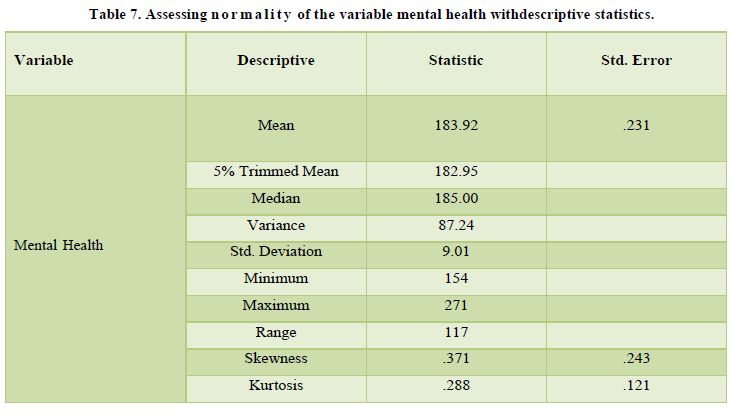
Descriptive Statistics Dependent Variable Mental Health (Table 8).
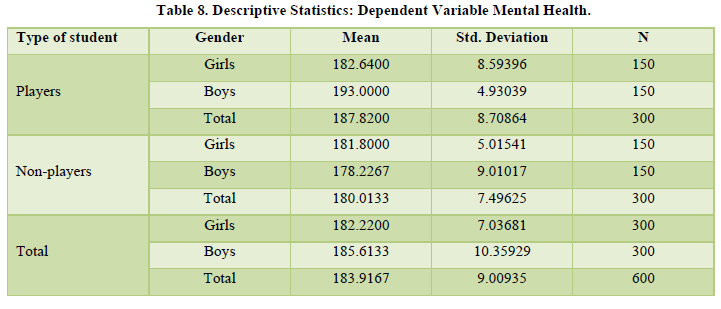
The above table provides the mean scores, standard deviations and N for each subgroup of the two independent variables and here mental health is treated as dependent variable. Inspecting the pattern of these values give us an indication of the impact of Independent Variable.
It was noted that the assumption of normality, level of measurement, and random sampling did not pose any problem for the ANOVA. The above analysis indicated that the assumptions underlying ANOVA are met quite satisfactorily in the present analysis, thus justifying the presentation of ANOVA (Table 9).
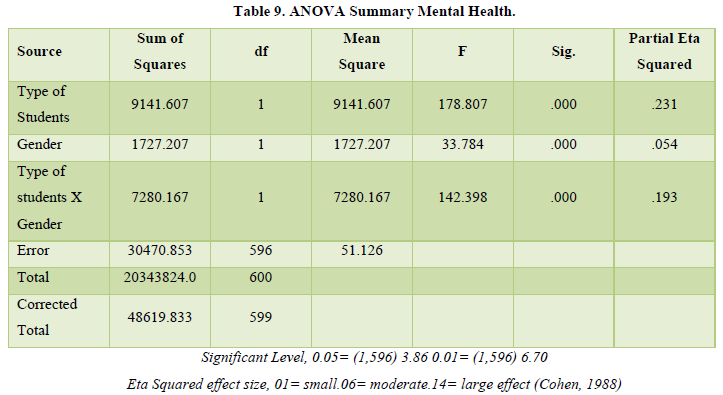
Assessing normality of the variable positive self-evaluation a component of mental health with descriptive statistics (Figures 1 & 2).
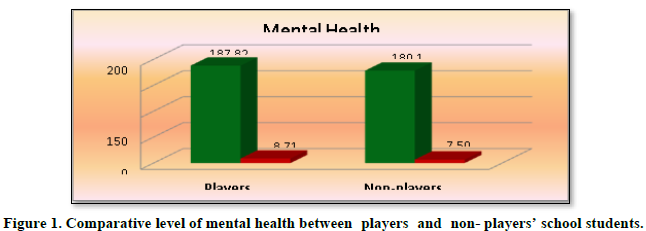
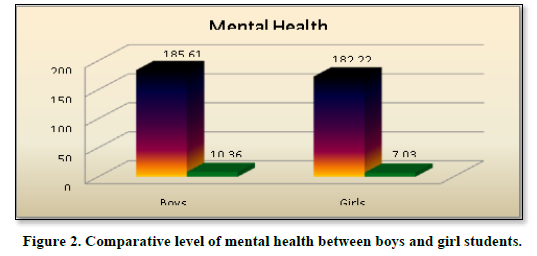
Descriptive statistics of whole sample (N=600). Mean is 67.56 which is close to the trimmed mean 67.70 (Table 10).
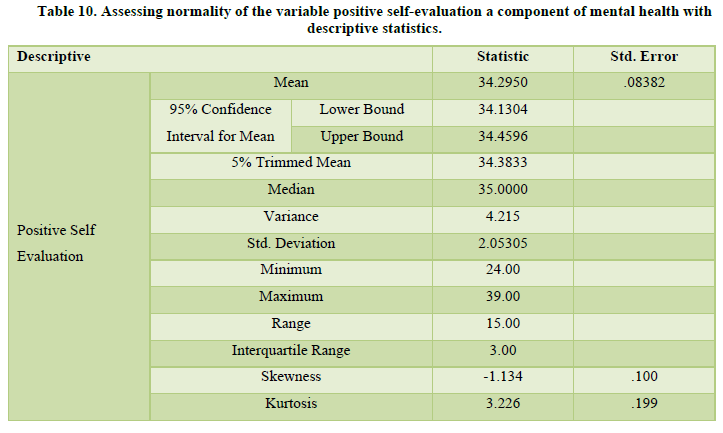
In the above table showing a descriptive statistics of whole sample (N=600). Mean is 67.56 which are close to the trimmed mean 67.70. Hence, we conclude here that the data is unaffected by extreme values (outliers) (Sheridan, J Coakes, 2006). Median (68.00) is greater than the mean (67.56) and it interprets that the distribution of scores is somewhat negatively skewed. Variance is 195.51, SD is 13.98 and the range between highest and lowest score is 79.00. The value of kurtosis (.274) is greater than 0.263, the distribution is said to be platykurtic; means distribution of scores is somewhat ‘flattened’ (Julie Pallant, 2001) (Table 11).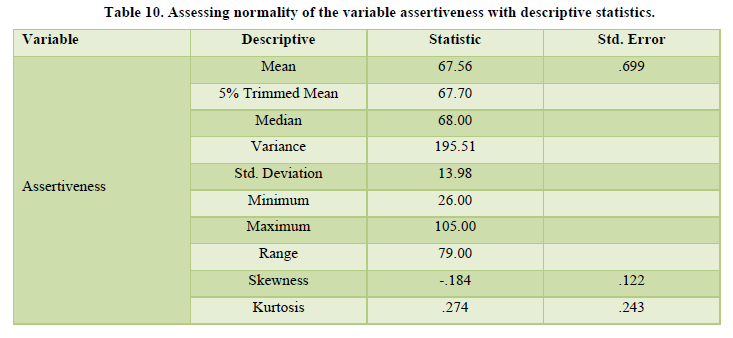
It was noted that the assumption of normality, level of measurement, and random sampling did not pose any problem for the ANOVA. The above analysis indicated that the assumptions underlying ANOVA are met quite satisfactorily in the present analysis, thus justifying the presentation of ANOVA results below (Table 12).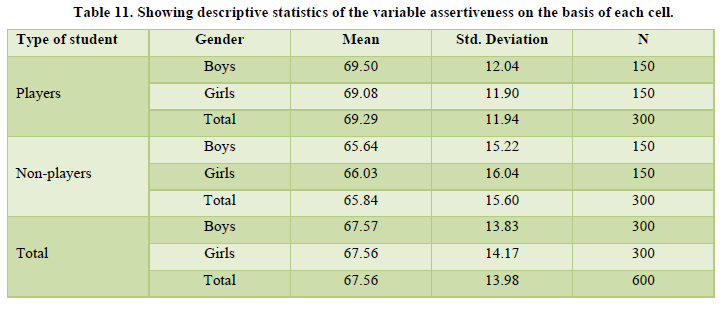
The above table (Table 12) provides the mean scores, standard deviations and N for each subgroup of the two independent variables and here assertiveness is treated as dependent variable. Inspecting the pattern of these values give us an indication of the impact of Independent Variable.
Players have self-confidence, self-acceptance, self-identity, feeling of worth wholeness, realization of one’s potentialities, etc. Acceptance of self, self-confidence, and self-reliance characterize the mentally healthy person (Figures 3-11).
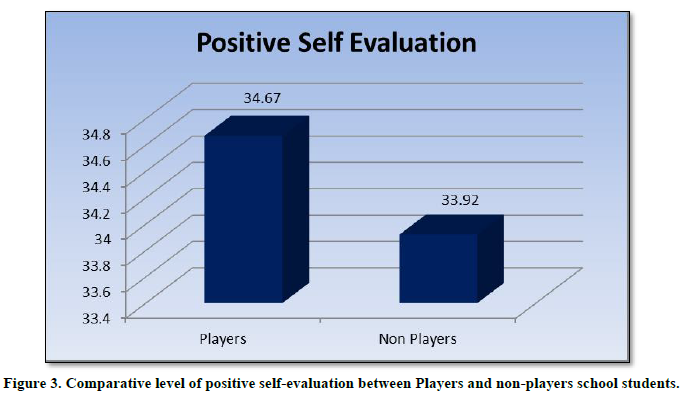
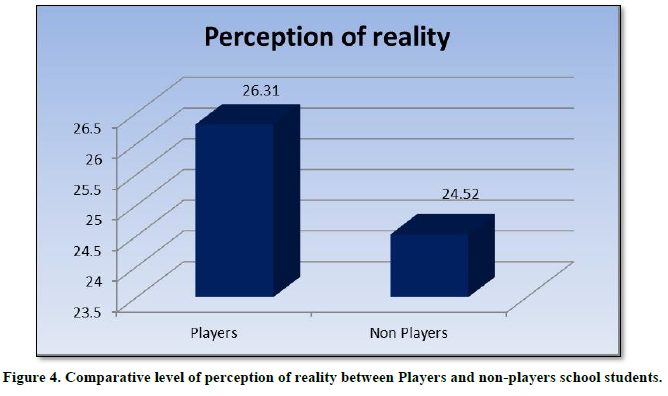
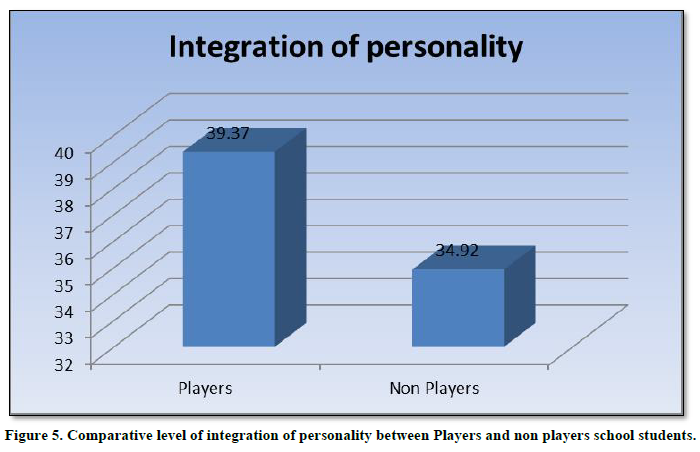
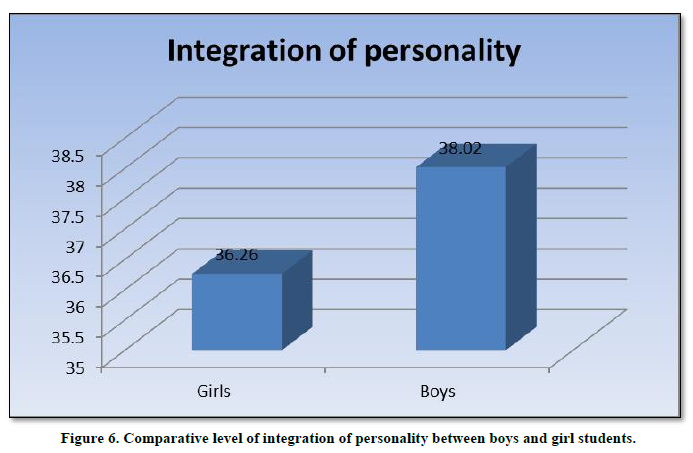
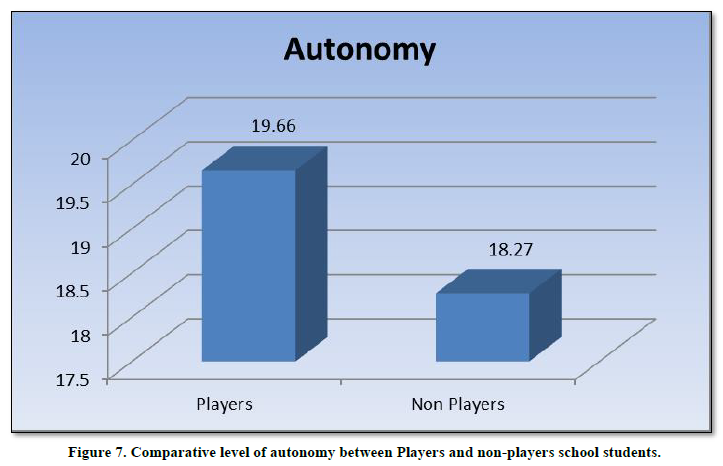
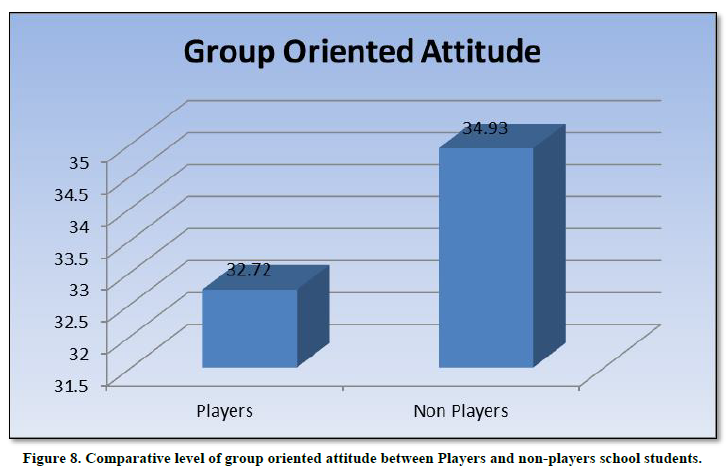
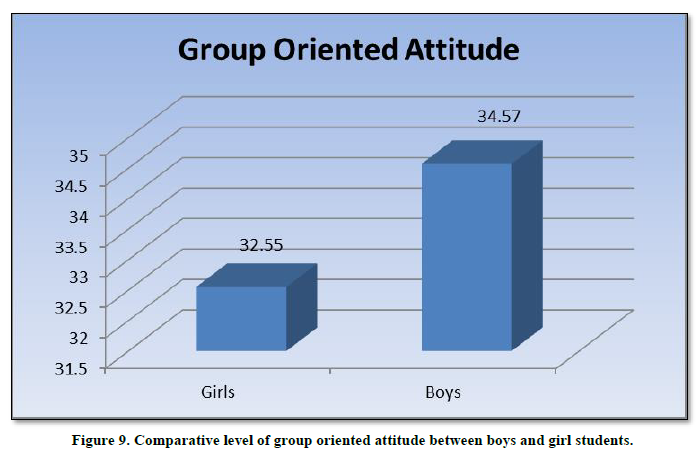
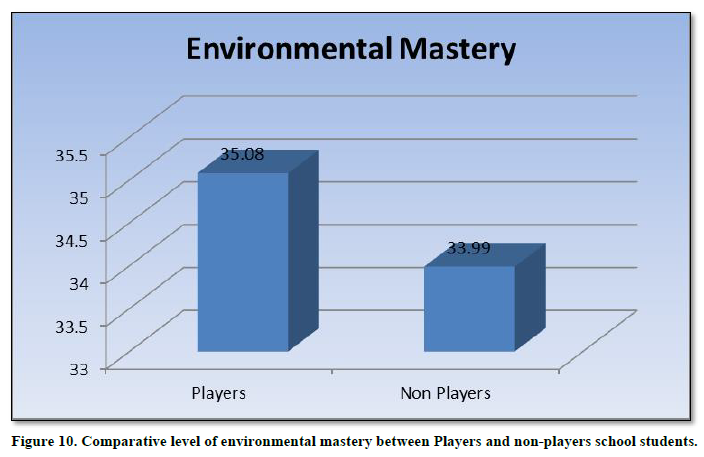
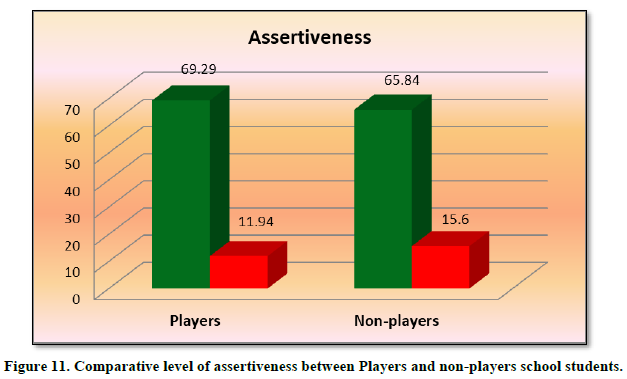
In one study, Tuckman, Bruce W.; Hinkle, J. Scott, (2006) have been Compared the effects of running to those of the normal physical education program among 154 4th, 5th, and 6th graders who were randomly assigned to conditions. The running program consisted of 3 30-min sessions per week for 12 weeks in lieu of attendance in regular physical education classes. Findings show that although boys tended to run faster than girls overall and that older children ran faster than younger children, running Ss performed better on an 800-m run, had lower pulse rates, and performed better on a test of creativity than did regular physical education participants. Running was judged effective for enhancing the cardiorespiratory health and creativity of school children.
Relevance of several factors to players' aggressive behavior has been extensively studied. Sport-related factors were studied in the framework of context-personality (Isberg, 1985, 1986, 1989) or context-gender (Rainey, 1986; Kemler, 1988; Bond & Nideffer, 1992). Relationship Teams' moral atmosphere, team norms regulating aggressive acts, and players' perception of these norms are mentioned to be important in this circumstance (Stephens & Bredemeier, 1996). Difficulty of the task (McGowan & Schultz, 1989) and use of anabolic steroids (Lefavi, Reeve, & Newland, 1990) also appear to be relevant to aggression in sport. The relevance of communicating factors was also studied (Hanin, 1980) and practically discussed (Hanin, 1992).
SUMMARY
The present study was an attempt to study the physical education, mental health and assertiveness of secondary school students of Chandwad Tehsil. Previous chapter represents data analysis and results, whereas this chapter gives us an idea of the research in brief. In this chapter researcher has presented summary, conclusions, limitations and suggestions with recommendations.
Summary of the study
The title of the investigation is _A Critical Study of Mental Health, Physical Education and Assertiveness of Secondary Students of Chandwad Tehsil‘. With reference to this title the first chapter entitled introduction, incorporated the main concepts such as, mental health, its dimensions, physical education, training and assertiveness of secondary school students of Chandwad tehsil. Researcher has been delineated a concept of secondary school student and also included back ground and significance of the research.
The second chapter regarding review of the literature, in this chapter researcher included various studies on physical education, mental health and assertiveness of students. All the studies are associated with present day situation. Some studies are not completely but partly related to the present hypothetical variables, which are included in the study.
The third chapter is research methodology. The samples means subjects were drawn from the schools of Chandwad tehsil, Nashik district. These schools and samples were randomly selected. The age range of the sample was 10 to 15 years. Here, researcher used 2x2 factorial research designs. In this section the researcher has mentioned the objectives, hypotheses, variables, operational definitions, design of the study, standardized tools for the purpose of data collection, all these methodological concepts tried to explain very clearly which are helpful for explain the design of research.
In the fourth chapter i.e. data analysis and results is incorporates analysis of the data, interpretation of results and discussion of data through the hypotheses. This is a survey type research. Hence, researcher has employed and fulfills all the requirements of survey research. By using the 2x2 factorial design and ANOVA was used for analysis of data. In this chapter mean scores of two groups were compared. ANOVA (Analysis of Variance) and LSD (Least Significant Difference) statistical techniques were used for data analysis. After calculating all components of mental health and assertiveness, produced significant results and converted our thinking into reality of the behavior of students with scientific base.
The fifth chapter is brief summary and conclusions of said research where the researcher has presented the summary of the research, conclusions, limitations and suggestions. Finally references are mentioned.
CONCLUSION
Findings are substantial and relevant on the line of hypotheses. These salient results are mentioned here in brief.
The effect of physical training has been found in type of student. I.e. Students who involved in physical education activities are show better mental health characteristics than those who are not involved in physical activities.
Gender difference has found in terms of mental health. Boys student of secondary education have better mental health than girl students‘.
According to assertiveness trait of personality, it is found that students who involved in physical education activities are more assertive than those who are not involved in physical activities.
Assertiveness trait is equally works in boys and girls. No gender difference is found in terms of assertiveness.
Significant relationship is found between physical training and mental health of the students. There is a positive relationship between physical education and mental health.
As well as assertiveness is associated with physical education training. There is a positive relationship between physical education and assertiveness.
LIMITATIONS
The research design, procedure, and results, when critically examined, lead to the impression that the present study is replete with a number of limitation which must be borne in mind in any attempt to generalize form and interpret the findings. The main limitations have been listed below:
The concept of physical education, used in the present research has been that of exercise of students. This exercise has various forms and types. The findings, therefore, cannot be explained bird eye view.
The assertiveness ability and mental health have also been measured by means of verbal tests. The criticisms advanced by psychologists against verbal, self-report inventories are, therefore, applicable to all these measures.
The sample for the study consisted of male and female secondary school students; therefore, the findings are not applicable to the general population or the illiterate children. Since the sample was drawn from the urban and rural area of Chandwad tehsil, which is a part of Nashik district, Maharashtra, which has a distinct culture, precaution should be taken in generalizing about other sub-cultural groups, on the basis of the present findings.
One limitation of the present study is related with the use of demographic variable-gender and type of school. It should be noted that demographic variables of whatever social importance they may be, are not psychological variables and present the danger of fostering erroneous interpretations and unjustified complacency. This point has been emphasized by Sechrest, (1976) in the following words:
"The problem with demographic variables in psychological studies is that they really end up being surrogate variables, but it is rarely possible to know for what real variables they are surrogates in any given sense. Take sex as an example. When sex is included as a variable in personality research, the investigator is almost never interested in biological maleness or femaleness per se. Yet any given samples of males and females potentially differ in so many ways e.g. in field-independence, aggressive tendencies, self-esteem, interests, ambitions, sex-role orientation ... that it is difficult, if not impossible to know what specific characteristic might have been involved in a sex treatment interaction.
Apparently, most interpretations regarding differences associated with demographic variables are likely to be arbitrary and should be taken with caution.
The limitations of any paper pencil tests such as response biases, carelessness, positive and negative faking tendency somewhat affected the responses.
As there is a difference in individuals there may be some kind of lacuna in giving responses.
SUGGESTIONS FOR FURTHER RESEARCH
After giving thought over the findings of the present study and the realization of its limitations, following suggestions for further research to extend the present study can be made:
The study of the effect of physical education training and its impact on mental health, assertiveness etc. should also be made on different samples such as general population, illiterates and various sub-cultural groups so that broader generalizations may be arrived at. In this endeavor different types of training of physical exercises should be studied.
In any consideration of demographic antecedents of childrearing practices in the population from which the sample has been drawn should be studied. In this connection, studies of parent-child relationships, early childhood experience and family structure, in relation to physical exercise, are necessary. Such studies need to be made on different samples.
Studies on urban-rural differences should be made by varying the sex- composition of the samples. Such studies may perhaps resolve the contradiction in findings of different researches about urban-rural differences in performance in sports. Similarly, studies regarding positive way of performance relationship may be done after varying the range of intelligence in different samples. The findings of these studies may provide answer to the mutually incompatible results of different studies.
Perhaps the relation of physical exercise and training and other needs of an individual is a function of the coping styles of the group of which the individual is a member. It is, therefore, necessary to study coping styles, of different sub-cultural groups, in anxiety arousing situations.
The relation of games to personal variables has been mostly studied by using bi-variant methods. It is necessary to take up multivariate studies.
The role of situational, cognitive, and perceptual factors needs to be studied in relation to physical education.
There is ample scope to carry out the research in this area. A widespread research be carried out in the area of family related structures. Besides the variables studies in this research, the researcher can study variables such as area of residence i.e. urban and rural, caste, culture, religion, etc.
Systematic studies with other standardized tools should be done on the basis of school students’ attitudes and aspirations about life.
There should be provision of the participants with lack of infrastructure of playing materials, guidance and training centers to increase the achievement level, assertiveness and coping styles of anxiety on grass root level of resident area that will be helpful to enhance an achievement motivation among students.
Teachers Handbook (2007) Maharastra State secondary and Higher Secondary Education Board Pune Health and Physical Education Teachers Handbook.
Trembarche, P., Robinson, E.,& Graham L. (2007). Physical Education and its Effect on Elementary Testing Results.
Gary,S. (2012). Training to Teach Physical Education in an Opposite Sex Secondary School A Qualitative Analysis of Trainee Teachers Experiences. European Physical Education Review, 18,346-360.
Ruoff, Kenneth,M. (2013). A Literature Review Investigating the Relationship between Sports Participation and Psychological Well Being. Doctoral Research Paper Biola University.
Abelson, R.P. (1995). Statistics as principled argument. Hillsdale NJ Erlbaum.
American Psychological Association (2001). Publication Manual Washington DC Author.
Anderson Vidya L., Levinson Edward M., William,B., Kiewra Kathleen, R.(1999). The effects of meditation on teacher perceived occupational stress state and trait anxiety and burnout. School Psychology Quarterly, 14, 3-25.








